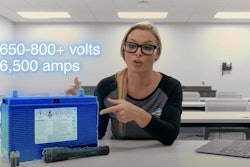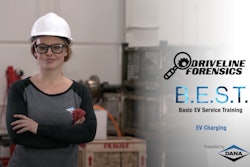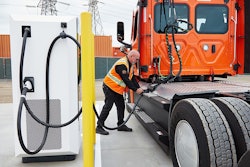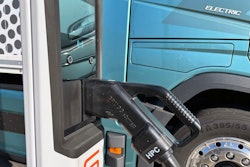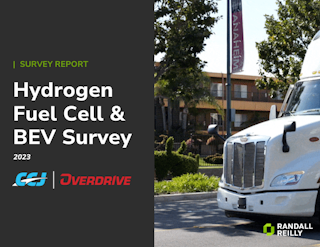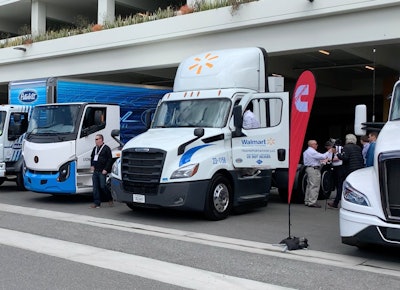
Though often touted as a critical bridge to zero emissions, internal combustion (ICE) trucks were few and far between at the recent Advanced Clean Transportation Expo in Anaheim, California.
Of the 26 trucks and vans listed in the two-day Ride and Drive event, only two were equipped with ICE powertrains: a Freightliner day cab from Walmart powered by Cummins new X15N natural gas engine and the hybrid Hyliion ERX equipped with Cummins ISX12N natural gas engine.
[Related: Delo 600 ADF certified for Cummins nat gas engines]
A stronger ICE showing among Class 8 was found inside the Anaheim Convention Center where ACT reported a record turnout of nearly 150 vehicles, the vast majority of which were battery electric.
However, all-electric and fuel cell trucks can’t come close to competing with long haul diesel’s range which typically exceeds a thousand miles miles on a single fill-up. Tesla’s Semi, which has yet to make an appearance at ACT Expo, currently boasts the most range at 500 miles. Hyundai and Paccar fuel cell trucks revealed at ACT Expo last week advertised 450 miles of range.
[Related: Penske pleased with renewable diesel]
But it's not just the range, it’s also the lack of infrastructure and the high equipment costs. There are only six hydrogen stations in the U.S. capable of fueling Class 8 trucks, all of which are located in California according to the California Energy Commission. Class 8 charger deployment is currently saddled with long wait times as CCJ recently reported.
High upfront costs are another factor. All-electric trucks cost roughly three times as much as diesel while fuel cell trucks are priced north of $800,000.
As zero emission technologies slowly make their way into Class 8 fleets—and that’s mainly California at this point thanks to generous grants and supporting infrastructure—OEMs continue to point to advancements in more affordable ICE technologies that can scale up fast and more quickly slash emissions across North America and beyond thanks to pathways to production and fueling infrastructure that have long been in place.
Walmart pleased with Cummins fuel agnostic approach
No stranger to the long bridge to zero emissions, Cummins showcased its 15-liter fuel agnostic ICE platform at ACT Expo alongside its new zero-emissions brand Accelera.While Accelera’s hydrogen electrolyzers, fuel cells, batteries and all-electric powertrains are gaining traction in the global marketplace, Cummins new X15N, part of the brand's new fuel agnostic powertrain lineup, is being viewed more as a road-ready, interim solution that can quickly cut emissions while meeting the challenging needs of long haul in North America and beyond.
“We have customers today that are doing long haul with our 12-liter natural gas engine,” said Tom Swenson, Cummins manager of global regulatory affairs. “We’ve got some customers that do the back of cab unit (CNG tanks) and they do side saddle (tanks along the rail) and get upwards of 1,200 to 1,300 miles.”
Walmart, which recently began piloting the X15N in a Freightliner day cab, plans on using the engine in long haul.
“Absolutely. That’s the goal, to put this on a sleeper,” said Wayne Wilson, senior manager of sustainable transportation at Walmart.
[Related: CCJ Innovator Walmart enjoys success with their first in-house driver app]
Walmart’s truck made the journey from Indiana to Anaheim under its own power unlike zero emission trucks that had to be hauled there because of a lack of fueling infrastructure. The truck fueled up at Chevron’s Beyond6 CNG stations along the way. Those stations offer carbon negative renewable natural gas (RNG).
“I’ve driven this truck fully loaded at 82,000 GCW and our drivers love the power, they love the torque,” Wilson said. “The fueling’s easy for them. They were amazed at the cost of fueling. We had a half a tank and we filled it with less than a hundred bucks.”
So far the X15N is showing fuel economy of 6 to 6.5 mpg which Wilson pointed out is about 25% less energy efficient than diesel but when fueled by renewable natural gas, carbon reduction in the X15N can’t be beat.
“With RNG we can be carbon negative with this,” Wilson continued. “Honestly, battery electric and fuel cell isn’t going to go 900 miles. We can take this and with more tanks we can do long range.”
That means having the means to reduce emissions while traveling through areas where electrification will be a long time coming.
“We’re betting big on this and it’s also part of the fuel agnostic platform that will run on hydrogen as well. In two years we’ll have a new head for that and it will run on hydrogen as well. We’re looking forward to that,” Wilson said.
Walmart’s not backing away from all-electric and fuel cell. The Arkansas-based retailer got an early start with fuel cell in 2016. Fifty of their distribution centers are running fuel cell forklifts and “by the end of this year, we’ll have 70,” Wilson said.
Electric and fuel cell trucks have their place as well.
“We’re counting on fuel cell to be our middle mile. BEV is going to be 250 miles and below. Fuel cell is going to be that 300 to 500 mile range. RNG and the biofuels are going to be 500 plus,” Wilson said. “We’re going to be expanding into renewable diesel pretty heavily this year.”
Using drop-in biofuels like RNG and renewable diesel can more quickly cut emissions among a wide lineup of proven powertrains as Walmart gets more familiar with the capabilities of cutting edge zero emission trucks.
A current pilot with the Nikola Tre fuel cell electric vehicle (FCEV) showed that the truck couldn't match the capability of internal combustion in all duty cycles.
“The problem is the long grades. Here in Southern California, when we run up through the mountains there are some grades there that are miles long,” said Walmart senior manager of sustainability Lance Sandmann. “The Nikola had to pull over on the side of the road loaded at 80,000 lbs. and recharge. It’s undersized which they’re all going to work through that with time.”
Accelera CEO Amy Davis pointed out during a media event at ACT Expo that Cummins offers the broadest lineup of powertrain options to better help fleets on what most industry experts are betting will be a long transition to zero emissions.
“We want people to adopt today and we want people to adopt zero solutions like Accelera offers but that’s not always feasible,” Davis said. “And so Cummins is also innovating in spaces to deliver lower emissions in traditional engines that can be cheaper and easier to deploy and they take carbon out immediately. So we’re offering the broadest selection of solutions to help our customers decarbonize now and meet stakeholders’ expectations.”

